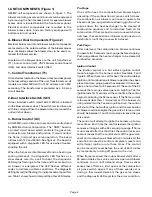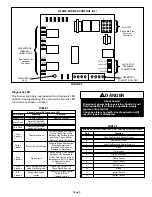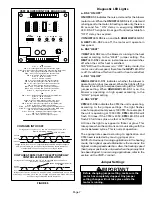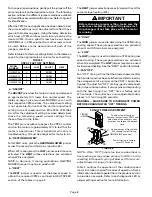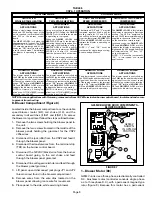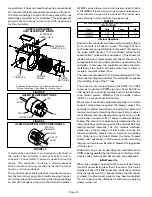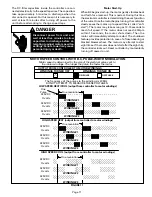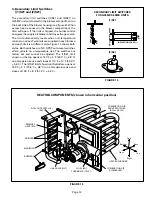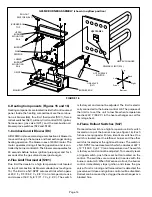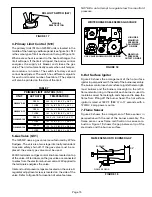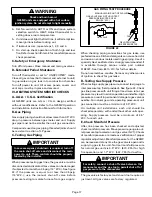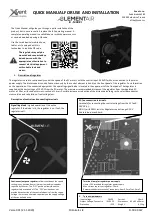
Page 12
External Operation (Speed Tap Priority)
Figure 12 shows the two quick-connect jacks (J48 and
J49) which connect the motor to the G25MV. Jack J48 is
the power plug and jack J49 connects the unit controls
to the motor.
Line voltage must be applied to J48 pin 5 in order for the
motor to operate. When using 120VAC pins 1 and 2
must be jumpered. When control voltage is applied to
J49 pin 3 and 15 (single stage heating and cooling), the
motor is energized on the low speed heat/cool tap.
When voltage is applied to J49 pin 2 in addition to pin 3
and 15 (second stage heating), the blower is energized
on the high speed heating tap. When voltage is applied
to J49 pin 10 in addition to pin 3 and 15 (second stage
cooling), the blower is energized on the high speed
heating tap. The motor assigns priority to J49 pin 2 so that
if a call for cooling and a call for heating are concurrent,
heating call overrides and the blower operates on high
speed heating tap.
FIGURE 12
POWER
CONNECTOR J48
CONTROL
CONNECTOR J49
BLOWER B3 HARNESS CONNECTORS
J49
PIN 1 - C1
PIN 2 - W / W1
PIN 3 - C2
PIN 4 - Delay
PIN 5 - Cool
PIN 6 - Y1
PIN 7 - Adjust
PIN 8 - 0ut
PIN 9 - 0
PIN 10 - BK / PWM
PIN 11 - Heat
PIN 12 - R
PIN 13 - EM / W2
PIN 14 - Y / Y2
PIN 15 - G
PIN 16 - Out +
J48
PIN 1 - Jumper PIN 1 to PIN2 for 120VAC line input only.
PIN 2 - Jumper PIN 1 to PIN2 for 120VAC line input only.
PIN 3 - Ground
PIN 4 - AC Line
PIN 5 - AC Line
1
1
DANGER
Do not attempt to repair electronically controlled
blower motor or VSP2-1. There are no field service-
able parts. If either component appears to be faulty
after following checkout procedure, replace entire
component then recheck for proper operation.
2–Choke Coil (L13)
A choke coil is used on all G25MV units. The choke is
located on the blower housing and is used to block radio
frequency interference.
Precautions
If the G25MV or its electronically controlled blower motor
is improperly or inadequately grounded, it may cause
television interference (commonly known as RFI or radio
frequency interference).
This interference is caused by internal switching fre-
quencies of the motor controller (see figure 13). TV
interference may show up as small specks or lines
which randomly appear on the TV screen accompanied
by pops or clicks in the sound. Before attempting any ser-
vice, make sure the indoor unit is causing the interference.
To check, disconnect power to indoor unit then check TV
for continued signs of interference.
TV interference may be stopped by making sure the
motor is solidly grounded to the cabinet (metal to
metal) and by making sure the cabinet is solidly
grounded. If TV interference persists, make sure the
television (and all affected RF appliances) are moved
away from the G25MV. Also make sure affected ap-
pliances are connected to a separate electrical circuit.
ÇÇÇÇÇÇÇÇÇÇÇÇÇ
ÇÇÇÇÇÇÇÇÇÇÇÇÇ
ÇÇÇÇÇÇÇÇÇÇÇÇÇÇ
ÇÇÇÇÇÇÇÇÇÇÇÇÇÇ
ÇÇÇÇÇÇÇÇÇÇÇÇÇÇ
FIGURE 13
ECM SWITCHING FREQUENCY
WINDING #1
WINDING #2
WINDING #3
OUTPUT FROM CONTROLLER TO MOTOR WINDINGS
O volts
325VDC
One cycle
O volts
325VDC
O volts
325VDC
The electrical pulses to the windings cycle on and off at a
rate of 20,000 cycles per second (20Khz, this is called the
switching frequency). The effective D.C. voltage can be var-
ied by changing the pulse width. The switching frequency is
necessary in order to vary the speed of the motor. If the mo-
tor is not securely grounded to the cabinet and if the cabinet
is not securely grounded, the switching frequency may
cause television interference.
One Pulse
O volts
325VDC
ONE
ELECTRICAL PULSE
Switching Frequency
20Khz
Ç
PULSE ON
PULSE OFF
Ç
Ç
WINDING OFF




